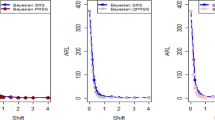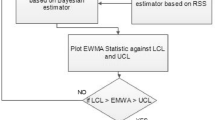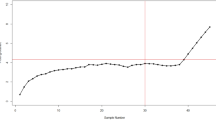Abstract
This article proposes a single weighted-loss-function chart (WL chart) for monitoring the process mean and variance simultaneously in statistical process control (SPC). The weights of the losses due to mean shift and variance shift in the loss function are balanced through a weighting factor λ, so that the WL chart is considerably more effective than the unadjusted loss function chart, the joint \(\overline{X}\)&S charts and many other charts as well. The improvement in detection effectiveness will directly lead to the reduction of a number of defects in the manufacturing process when out-of-control cases occur. Moreover, the WL chart provides a platform for the further development of the Cusum chart, runs rule, or adaptive chart for monitoring both process mean and variance.
Similar content being viewed by others
References
Montgomery DC (2001) Introduction to statistical quality control. Wiley, New York
Grabov P, Ingman D (1996) Adaptive control limits for bivariate process monitoring. J Qual Technol 28:320–330
Reynolds MR, Glosh BK (1981) Designing control charts for means and variances. In: Proceedings of the ASQC Quality Congress Transactions, American Society for Quality Control, San Francisco, CA, pp 400–407
Domangue R, Patch SC (1991) Some omnibus exponentially weighted moving average statistical process monitoring schemes. Technometrics 33:299–313
Sullivan JH, Woodall WH (1996) A control chart for preliminary analysis of individual observations. J Qual Technol 28:265–278
Amin RW, Wolff H, Besenfelder W, Baxley R (1999) EWMA control charts for the smallest and largest observations. J Qual Technol 31:189–206
Chen G, Cheng SW, Xie HS (2001) Monitoring process mean and variability with one EWMA chart. J Qual Technol 33:223–233
Cyrus D (1997) Statistical aspects of quality control. Academic Press, London
Spiring FA, Yeung AS (1998) A general class of loss functions with individual applications. J Qual Technol 30:152–162
Reynolds MR, Stoumbos ZG (2000) The SPRT chart for monitoring a proportion. IIE Trans 30:545–561
Sweet AL (1986) Control charts using coupled exponentially weighted moving averages. IIE Trans 18:26–33
Gan FF (1995) Joint monitoring of process mean and variance using exponentially weighted moving average control charts. Technomitrics 37:446–453
Reynolds MR, Stoumbos ZG (2001) Monitoring the process mean and variance using individual observations and variable sampling intervals. J Qual Technol 33:181–205
Author information
Authors and Affiliations
Corresponding author
Calculation of ARL of a WL chart
Calculation of ARL of a WL chart
The statistic WL (Eq. 6) is greater than Γ when
or
where,
Thus, the probability that WL is greater than Γ can be calculated by conditioning on the value of the sample mean \(\overline{x} .\).
where, \(f{\left( {\overline{x} } \right)}\) is the density probability function of \(\overline{x}\) that follows a normal distribution with the mean equal to \({\left( {\mu _{0} + \delta _{\mu } \sigma _{0} } \right)}\) and the variance equal to \({\left( {\delta _{\sigma } \sigma _{0} } \right)}^{2} /n;\) and \(p{\left( {\overline{x} } \right)}\) is the probability that WL is greater than Γ when the value of \(\overline{x}\) is given within the range between (μ0–a) and (μ0+a). From Eq. (15)
where, the random variable Q follows a Chi-square distribution with degrees of freedom of (n–1) and
Finally, the ARL of the WL chart is calculated by
The weighted loss function WL can also be expressed as
where, \(w{\ell }\) is a special case of WL under the standard condition (μ 0 =0, σ 0 =1). Recall Eqs. 13 and 23,
It indicates that, for a given set of values of \(\delta _{\mu }\) and \(\delta _{\sigma }\), a general-condition WL chart with a control limit UCLWL given by Eq. 13 produces the same ARL as a standard-condition WL chart with (UCLWL)standard.
Rights and permissions
About this article
Cite this article
Wu, Z., Tian, Y. Weighted-loss-function control charts. Int J Adv Manuf Technol 31, 107–115 (2006). https://doi.org/10.1007/s00170-005-0160-4
Received:
Accepted:
Published:
Issue Date:
DOI: https://doi.org/10.1007/s00170-005-0160-4




